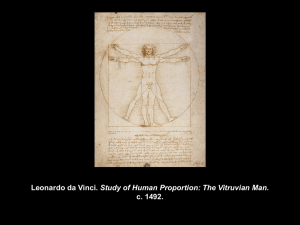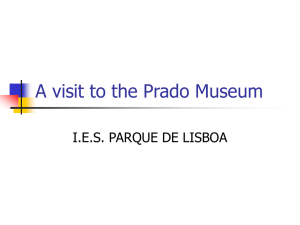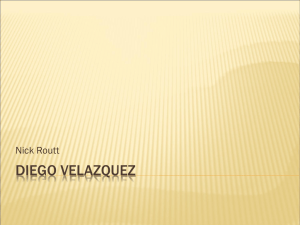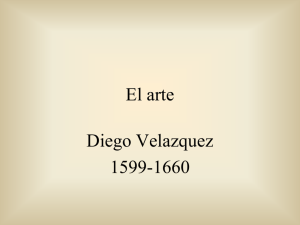italian and spain, 1600-1700
advertisement
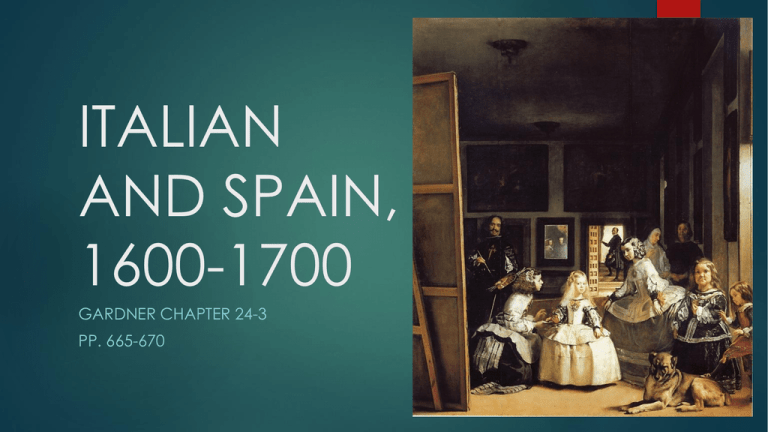
ITALIAN AND SPAIN, 1600-1700 GARDNER CHAPTER 24-3 PP. 665-670 SPANISH BAROQUE PAINTING Spain’s failure to capitalize on trading opportunities led to its slow decline beginning in the 17th century As in Italy, Spanish Baroque artists sought to move viewers and to encourage greater devotion and piety The greatest Spanish painter of the age was Velazquez. As court painter to Philip IV he painted many portraits, the best of which is Las Meninas. The work's complex and enigmatic composition raises questions about reality and illusion, and creates an uncertain relationship between the viewer and the figures depicted. From the first quarter of the 19th century, Velázquez's artwork was a model for the Realist painters JOSE DE RIBERA JOSÉ DE RIBERA, Martyrdom of Saint Bartholomew, ca. 1639. Oil on canvas, approx. 7’ 8” x 7’ 8” Influenced by Caravaggio -> Ribera made naturalism and compelling drama primary ingredients of his paintings Grim and dark in subject and form -> Saint Philip’s executioners hoisting him into position to die on the cross Martyrdom scenes were popular in Counter-Reformation Spain FRANCISCO DE ZUBARAN FRANCISCO DE ZURBARÁN, Saint Serapion, 1628. Oil on canvas, 3’ 11 1/2” x 3’ 4 3/4” Francisco de Zurbarán was also influenced by Caravaggio's naturalism and dramatic lighting effects His painting of Saint Serapionm shows the coarse-featured saint emerging in bright light from a dark background DIEGO VELAZQUEZ DIEGO VELÁZQUEZ, Water Carrier of Seville, ca. 1619. Oil on canvas, 3’ 5 1/2” x 2’ 7 1/2” Diego Velazquez -> Spanish painter who was the leading artist in the court of King Philip IV. In addition to numerous renditions of scenes of historical and cultural significance, he painted scores of portraits of the Spanish royal family, other notable European figures, and commoners, culminating in the production of his masterpiece Las Meninas (1656) Influence of Caravaggio seen in the dramatic contrast of darks and lights in Diego Velázquez's Water Carrier of Seville >also includes plebeian figures and finely painted, naturalistic detail Deceptively simple genre scene -> depicted w/a sacred quality Rounded qualities of the figures Water sweetened by a fresh fig placed for flavor SURRENDER OF BREDA DIEGO VELÁZQUEZ, Surrender of Breda, 1634–1635. Oil on canvas, 10’ 1” x 12’ 1/2”, Museo del Prado, Madrid Depicts the 1625 episode in which the Dutch were forced to yield the town of Breda to the Spanish Stresses the graciousness of the Spanish victors -> organized and well armed on the right The defeated Dutch on the left appear bedraggled and disorganized Dutch mayor of Breda hands the keys to the Spanish general who magnanimously stops the mayor from kneeling No encounter of this kind ever occurred VELASQUEZ AND PHILIP IV DIEGO VELÁZQUEZ, King Philip IV of Spain (Fraga Philip), 1644. Oil on canvas, 4’ 3 1/8” x 3’ 3 1/8”, The Frick Collection, New York One of the many portraits of Philip IV -> this one called the Fraga Philip -> painted while he was on military campaign in the town of Fraga Depicted as a military leader -> wearing exquisite attire w/baton and sword Note the large Habsburg jaw DIEGO VELÁZQUEZ, Philip IV in Brown and Silver (1631) This was definitely the first portrait the artist produced after his first trip to Italy, in that it adopts the softer and more colorful palette of the Venetian school. Life size, it is unlike most portraits of Philip IV, in that it does not show him in his usual wholly black costume. Instead it shows him in a brown and silver embroidered costume DIEGO VELÁZQUEZ , Old Woman Frying Eggs, (1618) Diego Velazquez, The Triumph of Bacchus or Los Borrachos - circa 1629 In the work, the god is represented as a person within the small celebration, but his skin is clearer than the other ones, to be recognized more easily. The scene can be divided in two halves. In the left, there is the very illuminated Bacchus figure, closer to the Italian style inspired by Caravaggio. Bacchus and the character left behind him refer to the classical myth and are represented by the traditional way. It can be highlighted the idealization of the god face, the clear light which illuminate him and a more classicist style. The right side, however, presents some drunkards, men of streets that invite us to join their party, with a very Spanish atmosphere, similar to Jose de Ribera’s style. There is no idealization in them, who present large and worn out faces. Neither the clear light which illuminates Bacchus is present in this side, and the figures are immersed in an evident chiaroscuro. In this work, Velázquez introduce a profane aspect on a mythological subject, a tendency he would cultivate more during the following years LAS MENINAS DIEGO VELÁZQUEZ, Las Meninas (The Maids of Honor), 1656. Oil on canvas, approx. 10’ 5” x 9’. Museo del Prado, Madrid Group portrait of the artist in his studio at work -> he steps back from the canvas and looks at the viewer Central is the Infanta Margharita of Spain with meninas (attendants), a dog, a dwarf, servants King and queen appear in a mirror Alternating darks and lights draw us deeper into the canvas; the mirror simultaneously reflects out into our space Dappled effect of light on shimmering surfaces Painting originally hung in Philip IV’s study LAS MENINAS Velázquez's great masterpiece Las Meninas shows the painter at work on a portrait with the King and Queen and members of the royal court present. His style is now more "painterly" and is concerned with producing more purely optical sensations through the manipulation of light and color tones
